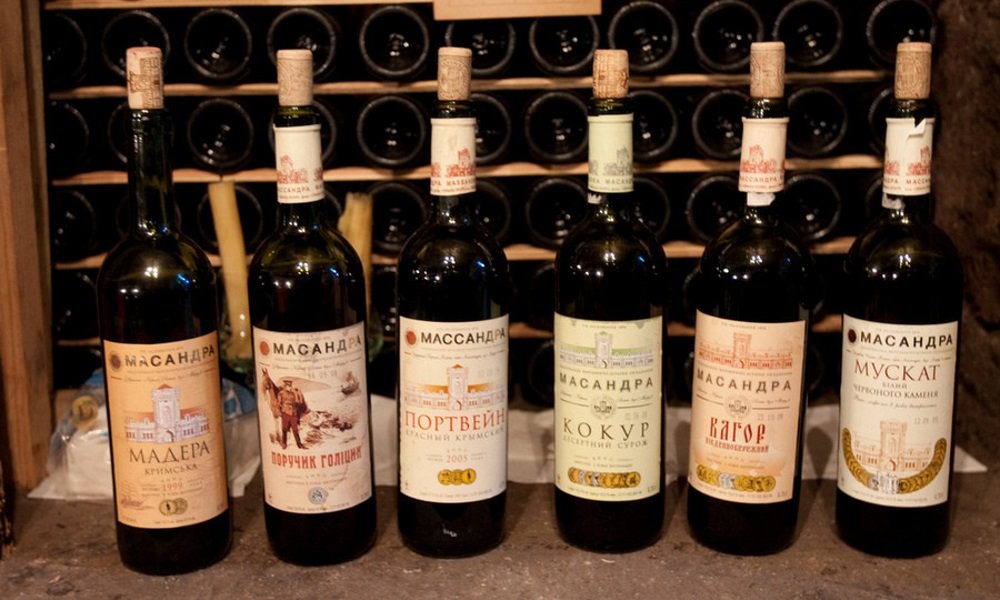The Russian annexation caused irreparable damage to the wine industry of Crimea: once world-famouswine brands of the Ukrainian peninsula are now referred to as ‘wine drinks’, famous fortified Crimean wines are removed from production because they don’t comply with the Russian standards and the vintage wines are sold out.
Crimean ‘wine drink’
Crimean wineries (“Massandra”, “Magarach”, “Novy Svet”) were one of the first enterprises came under the nationalization of Ukrainian state property and this is understandable since they not only generate a profit, but also became a certain brand identity for the peninsula.
Russia promised mountains of gold immediately after the annexation of Crimea: the Prime Minister Dmitry Medvedev promised both a law on wine to protect Crimean winemakers and full support of the wine industry in May 2014. However, it took more than two years – there is neither the law nor the promised billions to develop the industry. Instead of the support, peninsula’s winemakers got a lot of innovations, ranging from alcoholization standards to the size of warehouse spaces that eventually has a bad effect on the wine production.

The main problem Crimea faced with when moving to the Russian rules of games is the production technology questions. The problem is that it is allowed to fortify the wine only with ethyl alcohol in Russia, while Ukraine allows to do that with rectified alcohol from grain and other processed products. As a result, wines that have received international recognitionare referred to as ‘wine drinks’ according to the Russian standards.
“Can you imagine that our worldwide renowned “White Muscat of Red Stone” is a ‘wine drink’? Our pride – the Cahors wine “Yuzhnoberezhnuy”, Madeira “Massandra”, sherry “Maasandra” – they all are ‘wine drinks’! Our red port wine “Livadia”, which was a favorite port of Nicholas II, became the ‘wine drink’!” the then Director General of the NPJSC “Massandra” Nikolay Boyko complained in 2014.
Those wine makers who produced fortified wines also faced with difficulties and were forced to stop their production. There are two reasons for this: all the same production technology andtoo expensive licenses.
“In Russia, each activity requires a separate license and while it is about 800 thousand rubles a year for sparkling wines, it is 9.5 million rubles for fortified wines. We were not even going to get this license,” the director of the winemaking enterprise “Satera” Igor Samsonov explained.
It turns out that both a range of Crimean wines and a number of manufacturers are reduced thataffect the price of products. However, nobody is in hurry to make concessions for Crimea and this is understandable: the cost of the excise on wine drinks is ten times higher than on wines. Therefore, Crimean ‘wine drinks’ bring a good profit for Russia.
Wine production and sale on Russian standards
In addition to the technological features, there are a lot of other constraints that Crimean winemakers didn’t face with in Ukraine to produce the wine in Russia.
Firstly, the production of wine in Russia is not just expensive, but very expensive. It is related not only to a license and to a special alcohol, but also to the obligatory connection to the USAIS – the Unified State Automated Information System of accounting of the production and turnover of alcoholic products, the cost of which ranges from 3 to 5 million rubles that not all business can afford.
Secondly, the Russian legislation sets entirely different conditions regarding the rental of technological equipment and warehouse space standards for enterprises-producers. For example, the producers that don’t work on their own raw materials can’t use the rented equipment to produce wines. However, not all Crimean enterprises have their own vineyards – and this is related not only to small producers but also to such large factories as the Inkermanvintage wine factory, the Sevastopolchampagne factory, champagne factories “Novy Svet” and “Dionis”, the Feodosia wines and cognacs factory and others. The penalty for breaking the law is not a joke – the cancellation of licenses and withdrawal of products.
All these Russian innovations affected on the wine production volumes – it is produced in less volumes and the range of reduced with each passing day.
Russian concessions for Crimean winemakers
The Crimean ‘authorities’have repeatedly requested the federal center to extend the transitional period for peninsula’s winemakers to allow them reorganize their facilities with no hassles. The center relented and extended it but only for one year – to January 1, 2016.However, this does not work, and the Crimeans started again to run from pillar to post in Moscow to prevent the destruction of wineries.

Russia hesitated and, finally, decided to give some breaks to Crimea in June 2016. For example, according to the law adopted by the State Duma, in Crimea, it is allowed to produce a liqueur wine with a slightly lower alcohol content than it is commonly accepted in Russia: 12.5% instead of 15%. However, this can be done only prior to January 1, 2018.
The second concession is a permission to sell wine by glass, but only for those enterprises that produce wines with a protected geographical name and prior to January 1, 2017. Then they can sell wines from the wood via catering services during another year. Only “Massandra” got a protected geographical name by the end of the summer of 2016.
Click here to continue reading










